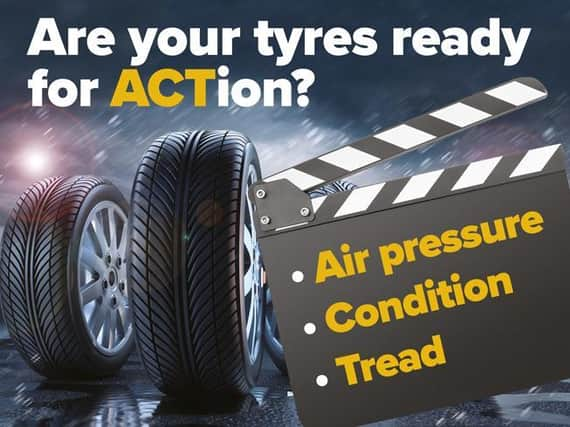Drivers in Warwickshire encouraged to ACT during 'tyre safety month'


Driver in Warwickshire are bring encouraged to ACT.
Warwickshire Police is supporting Tyre Safety month during October by asking drivers to 'ACT' by checking their Air pressure, Condition and Tread at least once a month and before long journeys.
Sergeant Shaun Bridle said: “Tyres are the only part of your vehicle that are in contact with the road you are driving on.
Advertisement
Hide AdAdvertisement
Hide Ad"For your safety and the safety of other road users it is vital your tyres are kept in a good condition and checked regularly for your vehicle to steer and brake effectively and stay on the road.”
In 2018/19 there was one fatal collision and one serious injury collision in Warwickshire where tyres being illegal/defective or under inflated was a contributory factor.
Officers working to reduce death and injury on Warwickshire’s roads regularly check tyre condition on vehicles they stop and during 2018/19, 55 people received Traffic Offence Reports due to the condition of their tyres.
Each bald or defective tyre carries a fine of up to £2,500 and three penalty points.
Advertisement
Hide AdAdvertisement
Hide AdEven though the tread depth of 1.6mm is the legal minimum, it is recommended that you replace your tyres once the tread is below 3mm - this is because stopping distances increase dramatically for cars below this tread depth, particularly in the wet.
Warwickshire Police are advising motorists to check the following:
Air pressure: use an accurate gauge to check your tyres are at the recommended air pressure settings found in the vehicle owner’s handbook or fuel filler cap.
At best, driving on under inflated tyres causes increased fuel consumption and poor handling but at worst the increased tyre wear could lead to the driver taking longer to come to a complete stop or losing control due to a blowout putting your life and the lives of other innocent road users in danger. Under inflated tyres also need replacing more regularly.
Advertisement
Hide AdAdvertisement
Hide AdCondition: Lumps or bulges in a tyre may indicate internal damage and increase the risk of a blowout.
If these, or cuts and cracks, are found while checking a tyre, the tyre may need replacing and you should not continue to drive on the tyre until professional advice has been sought.
Tread depth: Tyres with minimal tread depth lose the ability to channel water away from where the tyre meets the road surface.
This can lead to a layer of water between the vehicle and the road which reduces grip and increases the risk of losing control through over steering and skidding. Worn tyres are more prone to air leaking too.
Advertisement
Hide AdAdvertisement
Hide AdTread depth should be checked with an accurate gauge to ensure it is above the minimum legal limit of 1.6mm.
If you don’t have an accurate tread depth gauge, a 20p can be used as a guide to how close your tread is to the limit if you don’t have a tread depth gauge available